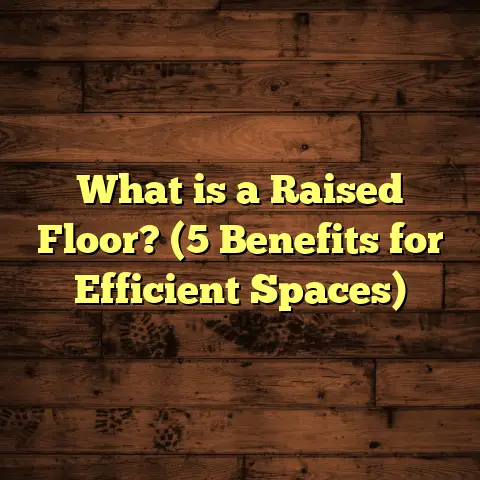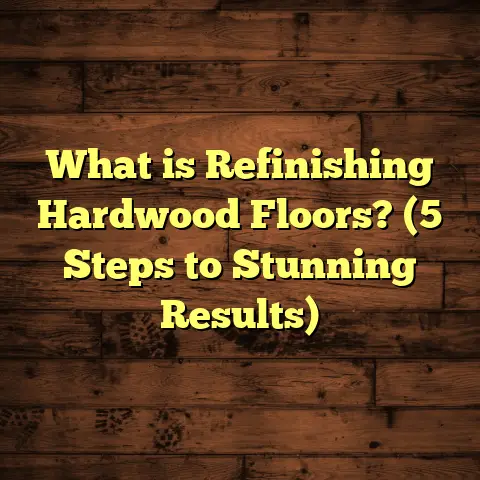What is Floor Grating? (5 Types & Their Best Uses Explained)
Eco-friendly flooring options have been on my mind a lot these days. It’s amazing how many choices there are now that help reduce environmental impact while still delivering the durability and style we want. One option I’ve worked with extensively that often flies under the radar is floor grating. You might not immediately think of it when talking about green flooring, but it offers some surprisingly sustainable benefits if you choose the right material and design. Plus, it’s an incredibly practical solution in many industrial, commercial, and even residential settings.
Let me walk you through what floor grating is, the different types I’ve installed over the years, and how you can select and maintain them based on your needs. I’ll also share some personal stories and data from real projects to give you a clearer picture.
What Is Floor Grating?
At its simplest, floor grating is a type of flooring composed of a grid or mesh made from materials like metal, fiberglass, or plastic. The key feature is that it’s open — meaning it has spaces between the bars or panels. This open design allows things like air, water, light, and debris to pass through.
Think of it as a floor that’s designed to be functional beyond just standing on. It can provide drainage so water doesn’t pool, ventilation for airflow in industrial environments, and slip resistance thanks to textured surfaces or serrated edges.
Floor grating can vary widely in size and shape depending on where it’s used. Some industrial platforms use very heavy-duty steel gratings that support massive loads. Other times you might see lighter plastic or fiberglass gratings in places where corrosion is a concern.
Why Use Floor Grating?
I remember early in my career, I was called to a factory where workers kept slipping on wet floors near machinery. They had tried mats and coatings but nothing was working. We suggested installing floor grating instead. It allowed water and oils to drain through instead of pooling on the surface. After installation, slip incidents dropped dramatically.
Here’s what makes floor grating stand out:
- Drainage: Open grids let liquids flow through instead of collecting.
- Ventilation: Air can circulate freely, preventing buildup of fumes or heat.
- Slip Resistance: Textured surfaces can reduce slipping hazards.
- Strength: Depending on the material, it can support heavy loads.
- Durability: Resistant to wear in harsh environments.
- Eco-friendliness: Many gratings are recyclable or made from recycled materials.
The 5 Main Types of Floor Grating & Their Best Uses
Floor grating comes in several types based on materials and construction style. I’m going to break down the five most common types I’ve worked with and explain where each one shines.
1. Steel Bar Grating
Steel bar grating is probably the most widely used type. It consists of steel bars welded or locked together into a grid pattern with openings that vary in size.
Why I Like It
Steel bar grating is incredibly strong and tough. It’s perfect for industrial environments where you have heavy equipment or foot traffic. Steel can handle high loads without bending or breaking.
In one project at a manufacturing plant, we installed galvanized steel bar grating for walkways above chemical tanks. Galvanizing added a protective zinc coating to prevent rusting from moisture and chemicals. Even after years of exposure, the grating looked almost new.
Best Uses
- Industrial walkways
- Platforms
- Stair treads
- Loading docks
- Heavy machinery areas
Installation Tips
- Always use proper anchors or weld points for secure fixing.
- Consider galvanizing or applying protective coatings if exposed to moisture.
- Serrated edges on bars improve grip and reduce slipping.
- Make sure load calculations are done based on usage.
Maintenance Advice
Steel gratings require regular inspections for rust or corrosion spots. Touch up with paint or galvanizing as necessary. Clean debris from openings so drainage isn’t blocked.
Environmental Impact
Steel is one of the most recycled materials globally. According to the Steel Recycling Institute, over 88 million tons of steel scrap were recycled in the U.S. in 2023 alone. Using recycled steel lowers energy consumption by up to 75% compared to new steel production.
2. Aluminum Grating
Aluminum grating is lighter than steel but still holds up well under load.
Why Choose Aluminum?
One of the biggest advantages is corrosion resistance. Aluminum naturally forms an oxide layer that protects it from rusting. That makes it great for marine environments or food processing plants where moisture is constant.
I installed aluminum grating at a seafood processing facility on the docks. The salty sea air would have corroded steel quickly. Aluminum held up beautifully for years without rusting or needing repainting.
Best Uses
- Marine docks and walkways
- Food processing areas
- Indoor/outdoor applications with moisture exposure
- Light to medium load platforms
Installation Tips
Because aluminum is lighter, it’s easier to handle during installation but still needs secure fastening with bolts or clamps.
Maintenance Tips
Minimal maintenance is needed aside from cleaning dirt and grime off regularly. Inspect for dents or bends especially if heavy items impact it.
Environmental Benefits
Aluminum recycling saves up to 95% of energy compared to producing new aluminum from bauxite ore. Many aluminum gratings contain recycled content, further reducing environmental footprint.
3. Fiberglass Grating (FRP – Fiber Reinforced Plastic)
Fiberglass grating is made by reinforcing plastic resin with glass fibers.
What Makes Fiberglass Special?
It’s non-metallic so it won’t rust or corrode at all. This makes it ideal for chemical plants or wastewater facilities where exposure to corrosive substances is common.
When I worked on a wastewater treatment plant upgrade, fiberglass grating was the obvious choice due to its resistance to acids and alkaline chemicals. Plus, it doesn’t conduct electricity — a safety bonus in certain areas.
Best Uses
- Chemical plants
- Wastewater treatment facilities
- Electrical insulation applications
- Outdoor walkways exposed to harsh weather
Installation Tips
Fiberglass can flex under very heavy loads so follow manufacturer guidelines strictly for span lengths between supports. Cutting requires special saw blades to avoid fraying fibers.
Maintenance Notes
Usually just requires routine cleaning. Watch for cracks or damage caused by impact or heavy point loads.
Eco-Friendly Angle
Fiberglass gratings last a long time without needing replacement which reduces waste over time. Some manufacturers now offer recyclable FRP products, though recycling options are more limited than metals.
4. Steel Perforated Grating
Instead of bars welded together, this uses sheets of steel with holes punched through.
When to Pick This?
Perforated steel grating gives you drainage with a more solid walking surface than open bar grids. It’s often used where people want better foot comfort but still need liquids to drain away.
I saw this used in commercial kitchens where grease and water spills are frequent but staff need a stable surface underfoot.
Best Uses
- Commercial kitchens
- Food service areas
- Light industrial walkways
- Wet areas needing slip resistance
Installation Tips
Because perforated sheets can be heavier than bar gratings of similar size, ensure supports are sturdy. Fasteners should be corrosion-resistant if outdoors or exposed to moisture.
Maintenance Advice
Keep an eye out for rust spots especially around holes where water collects more easily. Protective coatings help extend life.
5. Plastic Grating (PVC / Polypropylene)
Plastic gratings are made from heavy-duty plastics like PVC or polypropylene.
Why Use Plastic?
They’re corrosion-resistant against many chemicals and won’t rust like metals do. Plastic gratings are usually lighter than metal options which makes handling easier during installation.
I recommended plastic grating for greenhouse walkways because constant watering meant metal would have corroded fast. The plastic held up well for years without any issues.
Best Uses
- Greenhouses
- Light-duty walkways
- Access platforms in corrosive environments
- Areas sensitive to electrical conductivity
Installation Tips
Plastic can be easily cut with standard tools but avoid sharp impacts that might crack panels. Secure firmly to prevent movement that could cause wear.
Maintenance Tips
Clean regularly to prevent algae or mold buildup especially outdoors. Inspect for UV damage if exposed to sunlight—some types have UV inhibitors built-in.
Environmental Notes
Some plastic gratings are recyclable though recycling rates vary regionally. Lightweight plastic also reduces fuel use during transportation compared to metals.
How To Choose The Right Floor Grating For Your Project?
Choosing the right floor grating isn’t always straightforward. Here’s what I ask clients when helping select:
What Loads Will It Carry?
If you expect heavy machinery or forklift traffic, steel bar grating is often best because of its strength and durability. For pedestrian-only use with light loads, fiberglass or plastic might be enough.
What Environment Is It In?
Is there exposure to chemicals? Moisture? Saltwater? For corrosive environments, fiberglass or aluminum usually outperform steel unless steel is specially coated.
Is Drainage or Ventilation Needed?
Open grid designs allow water and air through easily — perfect for outdoor platforms or wet areas like food prep zones.
What About Budget?
Steel tends to be more expensive upfront than plastic or fiberglass but can last longer under heavy use which might save money long term.
Are Weight and Handling Important?
For rooftop installations or places where weight matters, aluminum or plastic options reduce load on support structures and ease installation effort.
Installation Tips & Tricks From My Experience
Installing floor grating correctly makes all the difference in safety and longevity:
- Check Load Ratings: Never guess weights; always confirm manufacturer specs.
- Secure Fastening: Use bolts, welds, or clamps recommended for your material.
- Add Anti-Slip Options: Serrated surfaces or coatings help prevent falls especially in wet environments.
- Allow Expansion: Metals expand/contracts with temperature changes; leave gaps where needed.
- Cutting Fiberglass/Plastic: Use carbide-tipped blades and wear protection gear; avoid chipping edges.
On one job involving fiberglass grating on a chemical plant catwalk, improper fastening caused panels to flex dangerously when workers stepped on them. We had to redo supports which delayed completion by weeks — so don’t rush this step!
Maintaining Floor Gratings: What I Tell Clients
Maintenance isn’t glamorous but skipping it leads to costly repairs or accidents:
- Inspect regularly for corrosion (steel), cracks (fiberglass/plastic), or loose fasteners.
- Clean openings often so debris doesn’t block drainage.
- Touch up coatings on metal gratings every few years.
- Replace damaged panels promptly before they become hazards.
A client once ignored rust on stair gratings until parts became unsafe; replacing those cost much more than regular maintenance would have saved them.
Why Floor Gratings Are Actually Pretty Eco-Friendly!
You might not have thought about floor grating as green flooring options before but here’s why they deserve credit:
Less Material Usage
Because they’re open grids rather than solid slabs, gratings use less raw material per square foot of coverage compared to concrete or wood floors.
Recyclability
Metals like steel and aluminum can be recycled repeatedly without losing strength—making end-of-life disposal far kinder for the environment than many other materials.
Longevity Reduces Waste
Durable gratings mean fewer replacements over time which lowers overall resource consumption.
Improves Air & Water Flow
Better ventilation reduces mold growth and improves indoor air quality in industrial settings.
Lightweight Options Save Energy
Lighter materials reduce fuel use during shipping and easier installation means less equipment running onsite—both reducing carbon footprint.
A Case Study: How Floor Grating Solved Safety & Cost Problems For A Warehouse
Let me tell you about a warehouse retrofit project I managed recently:
The existing concrete floors were prone to water pooling near loading docks causing slips and mold buildup along walls. The client wanted a solution that would improve safety without breaking their budget.
We installed steel bar grating coated with an epoxy anti-slip finish over the concrete slabs near dock doors:
- Slip incidents dropped by 75% within six months
- Mold problems reduced drastically because water flowed through grates
- Cleaning time dropped by 40% since water drained naturally
The client was thrilled because not only did safety improve but overall maintenance costs went down significantly too—showing how smart material choices pay off beyond first impressions.
Final Thoughts: Floor Gratings Are More Than Just Functional Floors
When I talk about floor gratings with friends who aren’t in construction, they often picture boring industrial metal grids only found in factories. But after working on various projects over the years, I see them as versatile solutions blending performance, safety, sustainability, and style when picked right.
So if you’re exploring flooring options that need strength plus easy maintenance—or want something that handles moisture without rotting—floor grating deserves a spot on your shortlist.
If you want help figuring out which type suits your project best or need tips on installation and upkeep, just ask me anytime!





